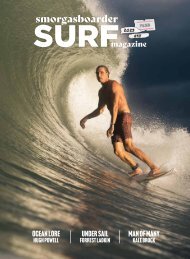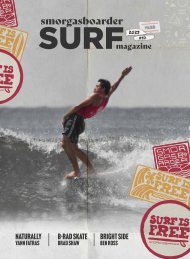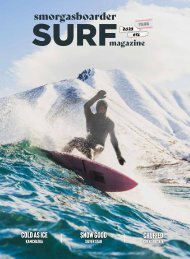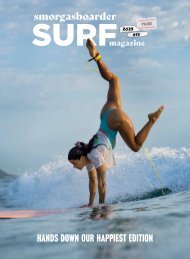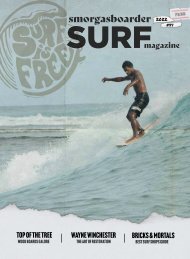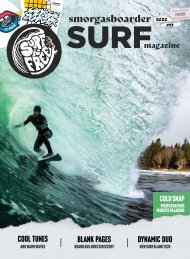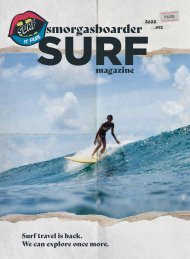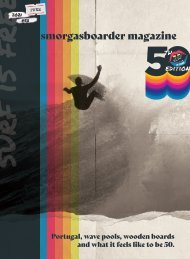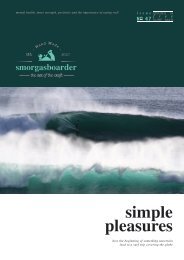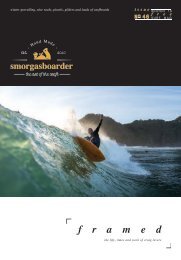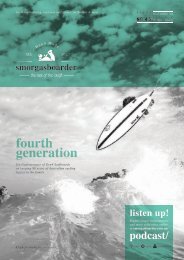You also want an ePaper? Increase the reach of your titles
YUMPU automatically turns print PDFs into web optimized ePapers that Google loves.
CLAYTON’S<br />
GET FIT TIPS FOR<br />
YOUR SURF TRIP<br />
MAKE<br />
THE MOST<br />
OF IT<br />
CLOSEOUT: FITNESS<br />
If you’re planning a surf trip in the near future now<br />
is a good time to start thinking about getting your<br />
body fit for the trip. Don’t spend all that time and<br />
money, then wind up pulling a muscle or being too<br />
fatigued to make the most of the waves on offer.<br />
So here’s the low down on how to get in shape and<br />
make the most of your surfing expedition.<br />
HOW LONG BEFORE THE TRIP SHOULD I<br />
START MY FITNESS TRAINING PROGRAM?<br />
It’s best to start your training plan at least a couple<br />
of months out from your trip to make sure you have<br />
enough time to get in shape. I would recommend<br />
three months training time, however you could still<br />
benefit from as little as four weeks training time.<br />
HOW MANY WORKOUTS EACH WEEK?<br />
You can get results with 2-3 workouts per week,<br />
however if you really want to make the most of it I<br />
would go for three functional strength workouts per<br />
week and three cardio workouts per week. You can<br />
also substitute cardio training for surfing, because<br />
at the end of the day, the best way to improve your<br />
surf specific cardiovascular fitness is to surf more.<br />
WHAT SHOULD MY WORKOUTS CONSIST OF?<br />
The warm-up<br />
Start with a good 5-10 minute warm-up to get<br />
ready for the workout. Instead of the traditional<br />
cardio warm-up, a smarter idea is to do bodyweight<br />
exercises that promote joint mobility, muscle<br />
activation and fundamental movement patterns. This<br />
will help prevent injury and improve your movement<br />
skills in addition to preparing your body to exercise.<br />
Bodyweight exercise like squats, lunges, push-ups,<br />
jumping jacks and so on are a great place to start<br />
for the warm-up.<br />
Functional Strength<br />
The next part of your workout should focus<br />
on functional strength exercises to build total<br />
body, multi-joint strength. Think about training<br />
movements, not muscles. To build a balanced<br />
body you should be doing exercises that include<br />
movements such as squatting, lunging, pushing,<br />
pulling, and lifting as well as exercises that promote<br />
balance, core stability and rotational strength.<br />
The most efficient way to train is to do the exercises<br />
either in a circuit or in supersets (where you do two<br />
or more exercises in succession with minimal rest).<br />
This allows you to work different muscle groups<br />
without having to spend as much time resting<br />
between exercises, which means a faster more<br />
efficient workout.<br />
You don’t need access to a gym, in fact you can do a<br />
great workout at home using only a set of adjustable<br />
dumbbells and a swiss ball. For your lower body<br />
try strength exercises like dumbbell squats, split<br />
squats, lunges and single leg straight leg deadlifts.<br />
For you upper body you can do exercises like<br />
dumbbell rows, swiss ball chest press, pull-ups and<br />
dumbbell shoulder presses.<br />
Finally you need to incorporate some core and<br />
balance training using exercises like planks, swiss<br />
ball rollouts, swiss ball jack-knifes, dumbbell chops<br />
and swiss ball balancing (on your knees or half<br />
kneeling).<br />
Cardio Training<br />
This can be done after the strength component<br />
or on the alternate days. For cardio exercise<br />
there are a number of different options such as<br />
running, riding, skipping, boxing, rowing, etc. If<br />
you have access to a pool or are near the ocean<br />
then swimming can be of great benefit as you can<br />
improve your lung capacity and also build some<br />
endurance in your arms and shoulders which can<br />
transfer into improved paddle fitness.<br />
If you don’t have a pool nearby you can also try band<br />
paddling to increase your paddle fitness. Do this<br />
by lying chest down on a swiss ball and paddling<br />
against the resistance of a light exercise band. This<br />
is a simple exercise you can do at home and can<br />
enhance the endurance in your arms and shoulders<br />
which is critical for a surf trip.<br />
The best cardio workout should be interval based<br />
where you do periods of harder work, mixed with<br />
recovery periods. This has been scientifically proven<br />
to effectively improve both your anaerobic (short<br />
burst) energy system and aerobic (longer duration)<br />
energy system, which is important for surfing. For<br />
example if you were swimming you could do a lap<br />
fast or sprinting followed by a lap slower recovery,<br />
then repeat for 10-20 laps. If you were running you<br />
could do 20 seconds fast, followed by 40 seconds<br />
recovery, repeat for 10-15 minutes.<br />
Stretching / Flexibility<br />
The final part of your workout should consist of<br />
some good old fashioned stretching to help promote<br />
increases in flexibility and aid in muscle recovery.<br />
Try and stretch all of your major muscle groups and<br />
hold stretches only to the point of tension, not pain.<br />
Once you have done this, that is your workout<br />
complete. A good total body workout like the one<br />
above shouldn’t take much more than an hour or so.<br />
Most of us have busy lives, so this is a good amount<br />
of time to spend exercising.<br />
OTHER SURF WORKOUT TIPS<br />
• Include some foam rolling (or self massage)<br />
before your warm-up to help improve muscle<br />
tissue quality and loosen any tight muscles.<br />
• Change up your routine about every 4 weeks<br />
to keep things fresh and challenging.<br />
• Drink plenty of water and eat a healthy diet –<br />
lots of fruits and vegetables, lean protein and<br />
wholegrains.<br />
• Surf as much as possible before the trip!<br />
• Ease back in your training about a week<br />
before you leave to make sure your body is<br />
fully recovered for the trip<br />
WHAT SHOULD I DO DURING THE SURF TRIP?<br />
So you have arrived at your destination and the lines<br />
are rolling in. What now? First thing is keep eating<br />
healthy to make sure you have plenty of energy. You<br />
can probably eat a few more carbs the day before<br />
a long surf, however don’t try and do anything to<br />
dramatically different to normal - just listen to your<br />
body. Stay well-hydrated before your surf sessions.<br />
Make sure you warm-up before you get in the water.<br />
You can do some stretching on any tight muscle<br />
groups, but make sure you also do more of an active<br />
warm-up, as this is a more effective way to get your<br />
body ready for the waves. Roll your arms around,<br />
do some squats and lunges to warm-up your knees,<br />
legs and hips and do some trunk rotations. This will<br />
help prevent any unwanted muscle strains and get<br />
your body switched on and ready to go.<br />
Finally, do some recovery work after each session.<br />
Stretching and foam rolling are the easiest options<br />
here and will do wonders for keeping your muscles<br />
in working order. Apart from that, catch lots of<br />
waves and get plenty of rest!<br />
SO THERE YOU HAVE IT.<br />
That’s my blueprint for getting fit for your next surf<br />
trip. If you want a comprehensive, step-by-step<br />
workout plan that maps out every exercise to get<br />
you in peak physical condition for the surf, visit<br />
www.TotalSurfingFitness.com and download the<br />
<strong>12</strong>-week functional training plan.<br />
LEFT: Clayton puts his<br />
fitness to use<br />
jul/aug 20<strong>12</strong><br />
<strong>12</strong>1




